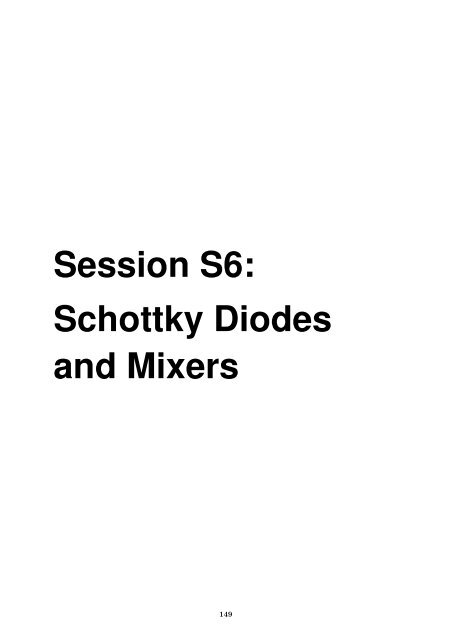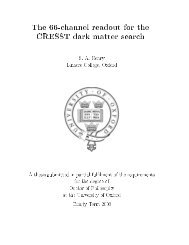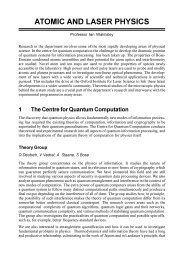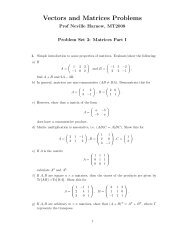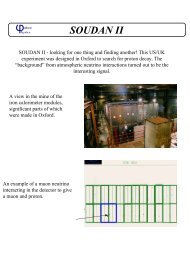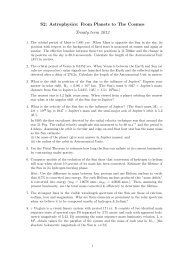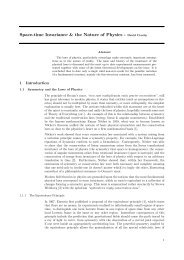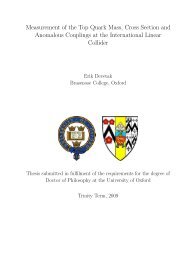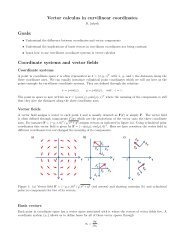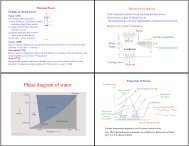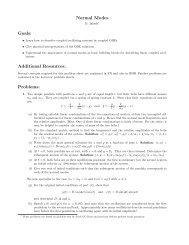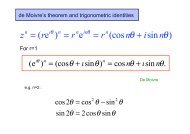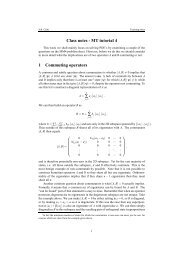Session S6: Schottky Diodes and Mixers - Department of Physics
Session S6: Schottky Diodes and Mixers - Department of Physics
Session S6: Schottky Diodes and Mixers - Department of Physics
You also want an ePaper? Increase the reach of your titles
YUMPU automatically turns print PDFs into web optimized ePapers that Google loves.
<strong>Session</strong> <strong>S6</strong>:<br />
<strong>Schottky</strong> <strong>Diodes</strong><br />
<strong>and</strong> <strong>Mixers</strong><br />
149
21ST INTERNATIONAL SYMPOSIUM ON SPACE TERAHERTZ TECHNOLOGY, OXFORD, 23-25 MARCH, 2010<br />
TeraHertz <strong>Schottky</strong>-Diode Balanced <strong>Mixers</strong><br />
Neal R. Erickson 1 <strong>and</strong> Thomas M. Goyette 2<br />
1 .Astronomy <strong>Department</strong>, University <strong>of</strong> Massachusetts, Amherst, MA, USA<br />
2. Submillimeter-wave Technology Laboratory, University <strong>of</strong> Massachusetts, Lowell, MA, USA<br />
Contact: neal@astro.umass.edu<br />
Abstract— We report on a very high performance THz balanced<br />
mixer/upconverter using a <strong>Schottky</strong> diode MMIC chip. Using<br />
an optically pumped laser at 1561 GHz as an LO source with a<br />
coupled power <strong>of</strong> about 1.5 mW, <strong>and</strong> 1.5 mW input at an IF<br />
frequency <strong>of</strong> 10 GHz, we obtained a sideb<strong>and</strong> output power <strong>of</strong><br />
45 W (sum <strong>of</strong> two sideb<strong>and</strong>s). As a mixer, at an LO <strong>of</strong> 1561<br />
GHz, we measured a mixer noise temperature <strong>of</strong> ~3000 K DSB.<br />
At the same frequency, used as a 16 th harmonic mixer the<br />
conversion loss is ~55 dB. The design b<strong>and</strong>width is 1250-1650<br />
GHz, <strong>and</strong> scaled devices have been fabricated for all frequencies<br />
through 3.5 THz, but the higher frequency designs have not<br />
been tested.<br />
Fig. 1 Schematic diagram <strong>of</strong> a balanced mixer with LO/IF input on the right<br />
<strong>and</strong> signal input waveguide on the left.<br />
I. INTRODUCTION<br />
In the THz range there is a need for room temperature<br />
mixers to act as both downconverters <strong>and</strong> upconverters using<br />
laser local oscillators. In these applications the relatively high<br />
LO power required by <strong>Schottky</strong> diodes is not a problem.<br />
This paper reports on a high performance THz balanced<br />
waveguide mixer built using a planar diode MMIC. This<br />
development was motivated by a need for a frequency agile<br />
sideb<strong>and</strong> generator at 1.5 THz which would use a laser as one<br />
input <strong>and</strong> a 5-40 GHz microwave synthesizer as the other.<br />
II. MIXER AND MMIC DESIGN<br />
The mixer developed in this work is similar to one used<br />
for pro<strong>of</strong> <strong>of</strong> concept testing [1], <strong>and</strong> is based on crossbar<br />
waveguide mixers [2] that have been made for many years in<br />
the mm-wave b<strong>and</strong>s. Fig 1 shows the basic circuit, with two<br />
diodes in series in the signal waveguide driven at their center<br />
point by the LO. This LO port is also the IF output which<br />
must be split <strong>of</strong>f from the LO. With separate LO <strong>and</strong> signal<br />
ports, no diplexer is required at the mixer input, <strong>and</strong> there is<br />
high isolation between these ports. A particular advantage <strong>of</strong><br />
this geometry is that the two diodes are in parallel to the IF<br />
port, halving the IF impedance. Given that single diode<br />
mixers typically have 100-150 IF impedances, this<br />
reduction eliminates the need for an IF matching circuit.<br />
The <strong>of</strong>f-chip IF circuit is simply a 50 ohm line.<br />
The MMIC chip designed for the mixer is shown in Fig 2,<br />
<strong>and</strong> its placement in the mixer in Fig 3. The device is built<br />
on 3 µm thick GaAs with beam lead contacts for ground, IF<br />
<strong>and</strong> bias. The fragile substrate is completely suspended by<br />
the beam leads. At the end <strong>of</strong> the LO waveguide probe a<br />
high impedance line continues along the axis <strong>of</strong> the<br />
waveguide through the backshort, forming the IF port. This<br />
creates little disturbance to the THz input circuit <strong>and</strong> there is<br />
little loss <strong>of</strong> power into the IF port. A thin SiN layer is used<br />
between metal layers to produce a bypass capacitor on the<br />
bias port, <strong>and</strong> to add a low impedance section <strong>of</strong> line to the IF<br />
port to improve the LO rejection.<br />
Fig. 2 Photograph <strong>of</strong> the diode used in the mixer. Overall height <strong>of</strong> the 1.5<br />
THz device (with leads) for is 570 um.<br />
Fig. 3 Balanced mixer cross section. The MMIC substrate is shown in<br />
green, metal in gold. Both waveguides transition to diagonal horns on<br />
opposite sides <strong>of</strong> the block.<br />
150
21ST INTERNATIONAL SYMPOSIUM ON SPACE TERAHERTZ TECHNOLOGY, OXFORD, 23-25 MARCH, 2010<br />
Two diode-MMIC wafers were fabricated at JPL using the<br />
very successful membrane process developed for Hershel<br />
HIFI [3]. The wafers had epi-layer doping <strong>of</strong> 5x10 17 /cm 3<br />
<strong>and</strong> 2x10 17 with identical circuit layouts. Variations <strong>of</strong> the<br />
design were scaled to as high as 3.5 THz, but tests reported<br />
here are <strong>of</strong> only the 1.5 THz design. Simulations <strong>of</strong> the<br />
performance <strong>of</strong> these designs indicate a relatively flat RF<br />
fractional b<strong>and</strong>width <strong>of</strong> 25%. Upconverted power is limited<br />
by the input power which is very constrained in a circuit with<br />
just two anodes, since the anodes must be very small for<br />
proper impedance matching. The required capacitance Cj(0)<br />
is 1 fF at 1.5 THz yielding an anode diameter <strong>of</strong> 0.5 m<br />
(scaling downward with increasing frequency). However, it<br />
is practical to add anodes in series, as has been done with<br />
multiplier circuits [4] In principle, using two anodes in series<br />
increases the maximum input power by a factor <strong>of</strong> four,<br />
assuming that the failure mechanism is related to power<br />
density within the device. This scaling comes about because<br />
for the same impedance level, each device can have twice the<br />
area if two devices are in series. In the case <strong>of</strong> failure due to<br />
heating, the scaling is much less obvious, since it depends on<br />
thermal pathways within the complete circuit, not just local<br />
device properties, but there is still some significant<br />
advantage. Four-anode devices were fabricated but the<br />
anode size was only 1.5 times larger so the maximum power<br />
in this case should only increase a factor <strong>of</strong> three.<br />
The best results were obtained with the 5x1017 doping<br />
devices, but this wafer yield is quite low, ~35% for 2-anode<br />
devices, <strong>and</strong> the yield seems to be near zero for 4-anode<br />
devices. The wafer with 2x10 17 doping works acceptably at<br />
1.5 THz, but it is clear that the doping is too low. This wafer<br />
has a high yield <strong>of</strong> 2-anode devices <strong>and</strong> 30% yield <strong>of</strong> 4-anode<br />
devices.<br />
As is apparent from Fig 2, these are very small devices.<br />
While the GaAs membrane can not be touched, the beam<br />
leads can be h<strong>and</strong>led safely, <strong>and</strong> installation in the block is<br />
done by positioning the device with a micro-manipulator.<br />
Once positioned, conductive epoxy is applied to the IF <strong>and</strong><br />
bias port leads. Because <strong>of</strong> the small contact area this can<br />
result in a high contact resistance, <strong>and</strong> a solder contact would<br />
be preferred, but is much more difficult to produce.<br />
The block was machined in brass as an E-plane split-block<br />
using conventional tools with a CNC micro-milling machine<br />
[5] <strong>and</strong> the block was then gold plated. Both waveguides are<br />
80 x 160 um, stepping up to square cross section before<br />
transitioning to diagonal feedhorns on both input <strong>and</strong> output<br />
ports. The diagonal aperture sizes <strong>of</strong> each were 1.5 mm.<br />
Details <strong>of</strong> the block are shown in Figs 3 <strong>and</strong> 5. The diode<br />
was installed with the beamleads clamped between the halves<br />
<strong>of</strong> the block. The IF port used a K type connector to allow<br />
tests up to 40 GHz, but in fact no dimension or circuit<br />
capacitance inherent to the design limits the b<strong>and</strong>width below<br />
~150 GHz. For practical reasons <strong>of</strong> testing <strong>and</strong> machining,<br />
the input waveguide was bent to align with the axis <strong>of</strong> the<br />
output guide. This adds LO loss but this is not a concern<br />
with laser sources.<br />
III. UPCONVERSION RESULTS<br />
Upconversion tests were done using an optically pumped<br />
laser at 1561 GHz, with an available power level <strong>of</strong> >10 mW<br />
<strong>and</strong> a variable attenuator before the mixer input. The IF was<br />
10 GHz from a synthesizer. For the tests with the 5x10 17<br />
doping devices, only 2-anode devices were available. Four<br />
mixers were assembled with these devices. These were<br />
driven with a laser power <strong>of</strong> ~1.5 mW (as measured by a<br />
coupling aperture comparable to that <strong>of</strong> the feed horn).<br />
<strong>Diodes</strong> were forward biased in operation, with the<br />
conversion efficiency rising with bias up to 1 mA (which was<br />
the maximum used). With an IF power <strong>of</strong> 1.5 mW, the<br />
output power from the best device in the two sideb<strong>and</strong>s is 45<br />
µW with only 5 µW <strong>of</strong> LO feedthrough (~25 dB LO-RF<br />
isolation). The feedthrough power was measured with the IF<br />
signal <strong>of</strong>f, but there is the possibility that the feedthrough<br />
may increase with IF applied. In previous tests with a similar<br />
mixer a very narrow b<strong>and</strong> FPI etalon was used to separate the<br />
LO from the sideb<strong>and</strong> signals. Use <strong>of</strong> this filter showed that<br />
there was no change in LO feedthrough with the IF applied.<br />
The THz input <strong>and</strong> output power were measured with a<br />
waveguide calorimeter (Erickson Instruments PM4) [6] built<br />
in WR10 waveguide with no transition between the horn <strong>and</strong><br />
the waveguide in the sensor. The size <strong>of</strong> the horns <strong>and</strong><br />
WR10 waveguide are fairly similar so coupling was expected<br />
to be good. For two other devices taken from very nearby<br />
on the wafer, output power was within 10%, while the fourth<br />
device from another region produced only 18 W.<br />
Fig 4 shows the power output vs IF drive power at the<br />
maximum laser power used <strong>of</strong> ~1.5 mW. Output power is<br />
compressed by ~1dB at 1 mW IF level, but is still increasing<br />
up to the maximum applied. There is the potential for higher<br />
output power, particularly with increased laser power, but<br />
diode failure due to heating is likely within a factor <strong>of</strong> 1.5<br />
higher input. RF dissipation within the diodes is difficult to<br />
estimate from diode bias since most <strong>of</strong> the THz input power<br />
is lost in parasitic resistances. Simply summing all the input<br />
power is the only way to estimate dissipation, which is ~4<br />
mW at the maximum output.<br />
Fig. 4 Output power vs 10 GHz IF drive with laser power <strong>of</strong> 1.5 mW. The<br />
solid line is a spline fit, with no physical model.<br />
151
21ST INTERNATIONAL SYMPOSIUM ON SPACE TERAHERTZ TECHNOLOGY, OXFORD, 23-25 MARCH, 2010<br />
Tests at other <strong>of</strong>fset frequencies show the same power<br />
output for an IF range <strong>of</strong> 2 to 40 GHz, with IF coupling<br />
nearly flat across this b<strong>and</strong>.. The RF b<strong>and</strong>width is predicted<br />
to be 1250-1650 GHz, but no other frequencies have been<br />
tested.<br />
The devices with 2x1017 doping showed significantly<br />
poorer performance. A 2-anode device showed significant<br />
saturation effects at 1 mA bias, <strong>and</strong> best output power was at<br />
0.5 mA. The power output saturated at 13 W, with an LO<br />
power <strong>of</strong> 1 mW <strong>and</strong> an IF power <strong>of</strong> 1 mW . The 4-anode<br />
devices worked better, but still required a bias <strong>of</strong> 0.5 mA<br />
although optimum LO <strong>and</strong> IF power increased to 2 mW <strong>and</strong><br />
4 mW respectively. At this drive level the output peaked at<br />
37 W, <strong>and</strong> began to decrease with increasing drive. LO-RF<br />
isolation with 4-anodes is excellent, just 2 W feedthrough,<br />
or ~30 dB LO-RF isolation.<br />
Perfect LO to RF isolation can never be obtained with this<br />
type <strong>of</strong> mixer because <strong>of</strong> the essential mechanical asymmetry<br />
between the anode <strong>and</strong> cathode <strong>of</strong> a planar diode. Isolation<br />
should be better at lower frequencies because the asymmetry<br />
couples to evanescent modes which become more important<br />
with increasing frequency. The 4-anode version <strong>of</strong> the<br />
design has much better isolation because the individual<br />
devices are smaller, <strong>and</strong> thus couple to even higher modes.<br />
A comparison between the 2-anode <strong>and</strong> 4-anode mixers<br />
with 2x10 17 doping shows that the output increases a factor<br />
<strong>of</strong> 3 with twice the anode number, as is expected for the<br />
anode sizes used With similar scaling, 4-anode mixers with<br />
5x1017 doping should produce an output power ~150 W.<br />
IV. DOWNCONVERTER RESULTS<br />
This device has been tested as a conventional mixer<br />
downconverter only at 1561 GHz. The IF source was<br />
replaced by a 3 GHz IF amplifier with a noise temperature <strong>of</strong><br />
~150 K. The mixer was the same one giving best results as<br />
an upconverter. With an estimated LO power <strong>of</strong> 1 mW <strong>and</strong> a<br />
bias current <strong>of</strong> 1 mA, a Y factor <strong>of</strong> 1.050 was measured with<br />
room temperature <strong>and</strong> liquid nitrogen cooled loads. This<br />
yields a complete receiver noise temperature <strong>of</strong> 4500K DSB.<br />
Assuming a typical noise contribution <strong>of</strong> a mixer diode ~300<br />
K, the estimated mixer noise temperature is 3000 K DSB,<br />
<strong>and</strong> the conversion loss ~10 dB. This is not an optimized<br />
result, with DC bias <strong>and</strong> LO power only roughly adjusted.<br />
The DC resistance <strong>of</strong> the IF contact to the MMIC is ~9 ohms,<br />
adding 1.4 dB to the conversion loss if capacitive bypassing<br />
<strong>of</strong> this resistance is not significant at 3 GHz. This noise is<br />
substantially lower than any other <strong>Schottky</strong> mixer results at a<br />
similar frequency, <strong>and</strong> is less than would be expected based<br />
on lower frequency results with waveguide mixers.<br />
Other types <strong>of</strong> mixers built for this frequency range all<br />
require cooling. THz <strong>Schottky</strong> mixers show noise reduction<br />
by only a factor <strong>of</strong> two [7] when cooled due to the high<br />
doping <strong>of</strong> the diodes, with no further reduction in the noise<br />
below ~50K. Therefore the best achievable receiver noise<br />
with this mixer might be ~1600 K DSB, but since the diode<br />
noise dominates, similar noise may be achieved up through a<br />
very high IF. A state-<strong>of</strong>-the-art waveguide HEB mixer at<br />
1350 GHz has a receiver noise temperature ~1200 K [8], but<br />
has much more restricted IF b<strong>and</strong>width <strong>of</strong> ~3 GHz, so this<br />
<strong>Schottky</strong> mixer may be very competitive, particularly in<br />
applications requiring wide b<strong>and</strong>width. Its reduced cooling<br />
requirements are another advantage, <strong>and</strong> many years <strong>of</strong><br />
experience with <strong>Schottky</strong> diode mixers at lower frequencies<br />
has shown them to have the best dynamic range <strong>and</strong> stability<br />
<strong>of</strong> any type <strong>of</strong> receiver.<br />
V. HARMONIC MIXING<br />
At these frequencies a quantum cascade laser could be the<br />
LO, leading to a simple all solid state receiver with wide<br />
frequency coverage through use <strong>of</strong> the >100 GHz wide IF.<br />
QCL’s can easily produce >1 mW output power, <strong>and</strong> can<br />
operate at ~50 K. Although output mode control can still be a<br />
problem, solutions are emerging that should produce good<br />
quality beams, <strong>and</strong> single frequency operation. A remaining<br />
challenge with QCL lasers is a means <strong>of</strong> locking their<br />
frequency since their free running stability is poor. At mm<br />
wavelengths, sources are typically measured by comparison<br />
to a microwave reference via harmonic mixing. This has not<br />
been possible in the THz range due to the need for high<br />
harmonics <strong>and</strong> the resulting very high conversion loss which<br />
typically increases as ~3 dB per harmonic. Using one <strong>of</strong><br />
these mixers, we attempted to measure a 1561 GHz laser<br />
mixed with an LO near 39 GHz (N = 40) but no signal was<br />
detected implying a conversion loss >120 dB (consistent with<br />
Lc~3dBN). To overcome this limitation complex multiplier<br />
chains [9] have been used to produce a reference signal<br />
which is mixed with the laser in a fundamental HEB mixer<br />
but this complexity is almost too great to justify the use <strong>of</strong> a<br />
laser LO. However, this new mixer can harmonic mix with a<br />
very high LO, reducing the harmonic number N to below 20<br />
<strong>and</strong> the conversion loss to ~60 dB.<br />
To test this application, a WR 10 waveguide was added to<br />
one mixer, coupling to the IF microstrip line, but leaving the<br />
coaxial IF port functional for low frequencies, as shown in<br />
Fig 5. The waveguide port is fairly well matched from 75 to<br />
~100 GHz, although only about half the power couples<br />
toward the mixer chip since there is no filter structure in the<br />
microstrip line.<br />
Fig. 5 Layout <strong>of</strong> the mixer block showing the added WR10 waveguide which<br />
allows low frequencies to couple from the mixer to the coaxial IF port at the<br />
top <strong>of</strong> the block. This waveguide is bent to <strong>of</strong>fset it from the LO feedhorn.<br />
152
21ST INTERNATIONAL SYMPOSIUM ON SPACE TERAHERTZ TECHNOLOGY, OXFORD, 23-25 MARCH, 2010<br />
With this wideb<strong>and</strong> port we mixed the 1561 GHz laser<br />
with an LO at 97.4 GHz. This LO was in turn derived from a<br />
commercial x8 active multiplier chain plus synthesizer. (N =<br />
16 for the mixer). The inefficient coupling is not a concern<br />
since the WR10 source produced more power (10 mW) than<br />
the diodes can survive. While setting up the test with a 2-<br />
anode mixer, one <strong>of</strong> the diodes was burned out but the test<br />
was continued with the surviving diode, <strong>and</strong> the mixer still<br />
worked well. The measured conversion loss was ~55 dB <strong>and</strong><br />
the S/N on a spectrum analyser was ~40 dB in 10 kHz<br />
resolution BW (<strong>and</strong> 300 Hz video BW). With 2 working<br />
diodes the conversion process should be more efficient since<br />
it favours even or odd harmonics (depending on the input<br />
port). With an LO in the 150-200 GHz range, harmonic<br />
mixing up to ~3 THz should be practical.<br />
VI. CONCLUSIONS<br />
Planar <strong>Schottky</strong> diode MMIC’s can serve as efficient<br />
upconverters <strong>and</strong> low noise mixers well into the THz range,<br />
<strong>of</strong>fering room temperature operation. The balanced mixer<br />
design separates the LO <strong>and</strong> IF ports, making an extremely<br />
simple, compact receiver requiring no LO/signal diplexer,<br />
<strong>and</strong> having no restriction on IF b<strong>and</strong>width. With cooling<br />
their noise temperature may be competitive with HEB mixers<br />
in applications requiring wide IF b<strong>and</strong>width <strong>and</strong> high<br />
stability. These mixers should be feasible throughout the<br />
THz range <strong>and</strong> devices have already been fabricated which<br />
may operate up to 3.5 THz. LO requirements are within the<br />
power available from QCL’s, <strong>and</strong> the combination should<br />
form very simple receivers. Harmonic mixers using the same<br />
design have low conversion loss <strong>and</strong> can serve to provide the<br />
frequency comparison needed to lock the QCL.<br />
ACKNOWLEDGMENT<br />
The authors wish to thank R. Grosslein for machining the<br />
blocks <strong>and</strong> R. Erickson for the assembly. The diodes were<br />
fabricated by Imran Mehdi’s group at JPL. M. Coulomb <strong>of</strong><br />
the UMass Lowell Submillimeter Technology Lab assisted in<br />
the tests.<br />
REFERENCES<br />
[1] N. Erickson, “A <strong>Schottky</strong>-Diode Balanced Mixer for 1.5 THz,”19th<br />
International Symposium on Space Terahertz Technology, pp. 221-<br />
223, Apr 08, Groningen.<br />
[2] S. Maas, Microwave Mixer 2 nd Eds, pp 291-293, Artech House, 1993.<br />
[3] A. Maestrini, J. Bruston, D. Pukala, S. Martin <strong>and</strong> I. Mehdi,<br />
“Performance <strong>of</strong> a 1.2 THz Frequency Tripler Using a GaAs<br />
Frameless Membrane Circuit,” IEEE MTT-S Int’l Microwave<br />
Symposium (Phoenix), pp. 1657-1660, May 2001.<br />
[4] B.J. Rizzi, T.W. Crowe <strong>and</strong> N.R. Erickson, ``A High-Power<br />
Millimeter-Wave Frequency Doubler Using a Planar Diode Array,"<br />
IEEE Microwave <strong>and</strong> Guided Wave Lett. vol 3, pp. 188-190, 1993.<br />
[5] G. Narayanan, N. Erickson, R. Grosslein, “Low Cost Direct<br />
Machining <strong>of</strong> Terahertz waveguide Structures,” Tenth International<br />
Symposium on Space Terahertz Technology, pp. 518-528, Mar. 99.<br />
[6] N. Erickson, “A Fast <strong>and</strong> Sensitive Submillimeter Waveguide Power<br />
Meter,” Tenth International Symposium on Space Terahertz<br />
Technology, pp. 501-507, Mar. 99.<br />
[7] P.F. Goldsmith, H.R. Fetterman, B.J. Clifton, C.D. Parker <strong>and</strong> N.R.<br />
Erickson, Cryogenic Operation <strong>of</strong> Submillimeter Quasioptical <strong>Mixers</strong>,<br />
International Journal <strong>of</strong> IR <strong>and</strong> MM Waves, vol 2, pp. 915-924, 1981.<br />
[8] D. Meledin, et al, “A 1.3 THz Balanced Waveguide HEB Mixer for<br />
the APEX Telescope,” IEEE Trans Microwave Theory Tech., vol<br />
MTT 57, pp. 89-98, 2009.<br />
[9] A.M. Baryshev, P. Khosropanah, W. Zhang, W. Jellema, J.N.<br />
Hovenier, J.R. Gao, T.M. Klapwijk, D.G. Paveliev,B.S. William, S.<br />
Kumar, Q. Hu, J.L. Reno, B. Klein, J.L. Hesler, “Phase-locking <strong>of</strong> a<br />
2.7-THz quantum cascade laser to a microwave reference,” 20th<br />
International Symposium on Space Terahertz Technology, pp. 49-52,<br />
Apr 09, Charlottesville.<br />
153
Full Waveguide B<strong>and</strong> <strong>Schottky</strong> <strong>Mixers</strong> for<br />
Terahertz Applications<br />
K. Hui, J.L. Hesler <strong>and</strong> T.W. Crowe<br />
Virginia <strong>Diodes</strong> Inc., Charlottesville, USA (Crowe.vadiodes.com)<br />
<br />
Abstract<br />
Although diode mixers have been supplanted by cryogenically cooled SIS <strong>and</strong> HEB mixers for ultra lownoise<br />
radio-astronomical purposes; <strong>Schottky</strong> mixers are still the best solution for most other scientific <strong>and</strong><br />
commercial applications. Their room temperature operation, broad signal <strong>and</strong> IF frequency b<strong>and</strong>widths <strong>and</strong> overall<br />
robust operation, coupled with their modest LO power requirements <strong>and</strong> relative sensitivity make them ideal for<br />
atmospheric studies <strong>and</strong> modern test <strong>and</strong> measurement systems, such as VNA frequency extenders. This paper will<br />
discuss the ongoing development <strong>of</strong> low-noise <strong>Schottky</strong> mixers that operate across complete waveguide b<strong>and</strong>s<br />
without LO power tuning <strong>and</strong> without DC bias requirements. These subharmonically pumped mixers are being<br />
developed to achieve very compact <strong>and</strong> easy to operate receiver systems that are ideal for planetary missions. As<br />
an example, the figure shows the measured mixer noise temperature <strong>of</strong> a WR1.9SHM being developed as a<br />
prototype for a proposed atmospheric probe for Venus. The goal is to cover the frequency b<strong>and</strong> from 440-590GHz<br />
with only a few milliwatts <strong>of</strong> LO power (220-295GHz) <strong>and</strong> a noise temperature <strong>of</strong> less than 2,000K, DSB. Results<br />
for an optimized version <strong>of</strong> this mixer will be presented at the conference.<br />
VDIWR1.9SHM<br />
3500<br />
3000<br />
Tm(K,DSB)<br />
2500<br />
2000<br />
1500<br />
1000<br />
500<br />
0<br />
360 380 400 420 440 460 480 500 520 540 560 580 600<br />
Freq(GHz)<br />
<br />
Fig. 1. The measured sensitivity <strong>of</strong> a broadb<strong>and</strong> WR1.9SHM design with flat LO power across the b<strong>and</strong>. The mixer<br />
designs being pursued use no DC bias <strong>and</strong> require no LO power adjustments as the frequency is tuned across the b<strong>and</strong>.<br />
The final mixer design will be optimized for the VESPER frequency b<strong>and</strong> <strong>of</strong> 440-590GHz.<br />
This effort is primarily funded through a NASA / GSFC SBIR contract (#NNX09CA57C), “<strong>Schottky</strong> Heterodyne<br />
Receivers with Full Waveguide B<strong>and</strong>width.”<br />
154
155
156
157
158
21ST INTERNATIONAL SYMPOSIUM ON SPACE TERAHERTZ TECHNOLOGY, OXFORD, 23-25 MARCH, 2010<br />
183 GHz Mixer on InGaAs <strong>Schottky</strong> <strong>Diodes</strong><br />
I. Oprea 1,3 , A. Walber 2 , O. Cojocari 1* , H. Gibson 2 , R. Zimmermann 2 , <strong>and</strong> H. L. Hartnagel 3<br />
1 ACST GmbH, Darmstadt, Germany<br />
2 RPG Radiometer <strong>Physics</strong> GmbH, Germany<br />
3 Technische Universität Darmstadt, Darmstadt, Germany<br />
*Contact: cojocari@acst.de, phone +49-6151-162762<br />
Abstract This work reports on experimental results <strong>of</strong> a 183<br />
GHz sub-harmonically pumped mixer based on InGaAs antiparallel<br />
diode pair. The diode structure provides extremely low<br />
parasitic capacitance <strong>of</strong> about 2.5 fF. Roughly estimated series<br />
resistance junction capacitance <strong>and</strong> ideality factor 10,<br />
4fF/anode <strong>and</strong> 1.2, respectively. The optimal LO-Power is as low<br />
as 0.34 mW, whereas usable performance can be achieved even<br />
with less than 0.2 mW.<br />
I. INTRODUCTION<br />
The <strong>Schottky</strong> junction is a generic technology, needed not<br />
only in space instruments but in practically all millimeter <strong>and</strong><br />
sub-millimetre equipment, with the imaging evolving fast to<br />
become the primary area <strong>of</strong> application. During the last years<br />
the rapid progress in the development <strong>of</strong> <strong>Schottky</strong> technology<br />
has allowed efficient heterodyne receiver systems at<br />
frequencies up to 1.5 THz [1][3]. As the applications<br />
require a constant rise <strong>of</strong> the operation frequency, the<br />
expense <strong>of</strong> LO power used to drive the diode to the needed<br />
conductance is still a concern. A reduction <strong>of</strong> the LO<br />
frequency <strong>and</strong> thus the LO power requirements is possible by<br />
using subharmonically pumped mixers (SHM), where<br />
normally the LO is one half the RF frequency. GaAs<br />
antiparallel <strong>Schottky</strong> <strong>Diodes</strong> used in subharmonic mixer<br />
unfortunately require a significant DC bias or high LO power<br />
to drive the diode to an optimum conversion performance.<br />
Since it is difficult to bias diodes in this way the low<br />
<strong>Schottky</strong> barrier height <strong>of</strong> InGaAs material reduces the<br />
required LO power relative to diodes based on GaAs [4], [5].<br />
<strong>Schottky</strong> barriers formed from In x Ga 1-x As have a height that<br />
decreases with increasing indium mole fraction. A lower<br />
barrier height means that a smaller LO Power is required to<br />
effectively pump the diode. The higher electron mobility in<br />
InGaAs in comparison to GaAs should play a role in<br />
minimising the series resistance which will reduce the<br />
conversion losses especially at higher frequencies. InGaAs<br />
mixers are also very interesting for potential use in integrated<br />
InP based millimetre <strong>and</strong> submillimetre wave receivers with<br />
state-<strong>of</strong>-the-art noise performance.<br />
II. ANTI-PARALLEL DIODE PARAMETER DETAILS<br />
The anti-parallel diode (APD) was fabricated by so-called<br />
Film-Diode process, which has been particularly developed<br />
at ACST for THz devices <strong>and</strong> circuits. The diode structure is<br />
based on the Quasi-vertical diode design, developed at<br />
Technical University <strong>of</strong> Darmstadt [6] <strong>and</strong> represents a<br />
discrete <strong>Schottky</strong> structure suitable for hybrid integration. In<br />
contrast to traditional planar structures, Film-Diode<br />
fabrication implies two-side processing <strong>of</strong> the semiconductor<br />
wafer, which implies a more complex fabrication, but is more<br />
flexible concerning the reduction <strong>of</strong> structure parasitics. In<br />
turn this provides a better potential for improving<br />
performance <strong>and</strong> allows operation at higher frequencies. The<br />
APD mixer diodes use an In 0.53 Ga 0.47 As active layer with a<br />
doping level <strong>of</strong> 8x10 16 cm -3 which is lattice matched grown<br />
on an InP substrate. Recently Schlecht [7] discussed the<br />
principle <strong>of</strong> an In 0.25 Ga 0.75 As based <strong>Schottky</strong> mixer, but no<br />
experimental results have been shown. Moreover the<br />
epitaxial growth <strong>of</strong> material with this indium mole fraction<br />
will not be lattice matched to InP <strong>and</strong> have much stress.<br />
The structures have 1.2 µm anodes in diameter <strong>and</strong><br />
estimated zero bias junction capacitance per anode is about<br />
4fF. The employed Film-Diode approach uses a transferred<br />
membrane substrate process which provides for strongly<br />
reduced structure parasitics. The shunt capacitance <strong>of</strong> APD<br />
diodes is as low as 2.5fF. The series resistance R s is extracted<br />
from simple I-V measurements <strong>and</strong> is slightly higher than<br />
expected. The high value <strong>of</strong> R s , approximately 10, can be<br />
caused by the wafer layout which was not optimised for<br />
mixing applications. On the other side the ideality factor is<br />
1.2 <strong>and</strong> is comparable to GaAs diodes. The calculated<br />
<strong>Schottky</strong> barrier height is around 0.21 eV <strong>and</strong> is about one<br />
quarter <strong>of</strong> the value for similar GaAs diodes. Figure 1 shows<br />
the typical I-V curves <strong>of</strong> an InGaAs <strong>and</strong> GaAs diode<br />
measured on-wafer. The typical turn-on voltage (1µA) for<br />
fabricated InGaAs diodes is below 50µV, which is drastically<br />
reduced in comparison to GaAs diodes.<br />
Fig. 1. Measured I-V Curves <strong>of</strong> InGaAs <strong>and</strong> GaAs <strong>Schottky</strong> <strong>Diodes</strong><br />
159
21ST INTERNATIONAL SYMPOSIUM ON SPACE TERAHERTZ TECHNOLOGY, OXFORD, 23-25 MARCH, 2010<br />
III. SUBHARMONIC MIXER PERFORMANCE<br />
Since the InGaAs material was available for comparison<br />
with GaAs, no new mixer<br />
block was designed. A<br />
similar mixer block was<br />
used as for 183 GHz ALMA<br />
subharmonic mixers<br />
developed by RPG. The<br />
employed mixer block was<br />
originally designed for<br />
ACST GaAs diodes, which<br />
typically exhibits state-<strong>of</strong>the-art<br />
performance <strong>of</strong><br />
T mix 450K. The mixer design is very similar to [8] but<br />
employs discrete diode mounting. A small picture <strong>of</strong> the<br />
SHM is inserted on the left. The waveguides for RF <strong>and</strong> LO<br />
signals are fabricated from quartz <strong>and</strong> the diode is soldered<br />
using indium solder. The double sideb<strong>and</strong> (DSB) noise<br />
temperature T sys <strong>and</strong> conversion loss L c <strong>of</strong> the mixer were<br />
measured using the st<strong>and</strong>ard Y-Factor measurement<br />
technique. One target at room temperature <strong>and</strong> another one<br />
immersed in liquid nitrogen are used at RPG as hot <strong>and</strong> cold<br />
load, respectively. The results are summarised in Fig. 2.<br />
TABLE I<br />
Tmix Lc (DSB) LO<br />
InGaAs 700 K -6.6 dB 0.34 mW<br />
GaAs 500 K (450 K) -6.0 dB (-5.7 dB) 3.0 mW(2.2 mW)<br />
As can be seen the mixer noise temperature, as well as the<br />
conversion efficiency is inferior to the results achieved with<br />
GaAs. However, this can be explained by the high value <strong>of</strong><br />
R s , which may result from the 70 nm thick active layer <strong>of</strong> the<br />
used wafer. The zero bias capacitance is slightly too high for<br />
183 GHz which also may limit the performance <strong>of</strong> the mixer.<br />
IV. CONCLUSIONS<br />
The first test performed by using InGaAs antiparallel<br />
diode structures in a sub-harmonically pumped mixer, where<br />
no DC bias was required, is extremely encouraging. The<br />
receiver performance is only slightly worse than with a GaAs<br />
diode, but the Local Oscillator requirements are drastically<br />
reduced. Due to recent advances <strong>of</strong> millimetre wave power<br />
generation technology, the obtained results may be<br />
considered insignificant. However, this approach may open<br />
new perspectives for higher frequencies, where LO power is<br />
still a concern.<br />
ACKNOWLEDGMENT<br />
The authors would like to acknowledge the ESA/ESTEC<br />
for supporting this study under contract No: 21628-08-NL-<br />
GLC.<br />
German Research Foundation (DFG) is acknowledged for<br />
support within the framework <strong>of</strong> Research Training Group<br />
1037 Tunable integrated components in microwave<br />
technology <strong>and</strong> optics (TICMO).<br />
REFERENCES<br />
Fig.2. IF Plot showing conversion loss (right) <strong>and</strong> noise temperature <strong>of</strong><br />
mixer for different LO powers.<br />
The shown data is raw data from the power measurements<br />
<strong>and</strong> is not corrected for losses or mismatches in any way. It<br />
includes waveguide losses as well as the IF amplifier noise<br />
contribution. Although the measured mixer temperature is<br />
higher in comparison to state-<strong>of</strong>-the-art performance, it is<br />
still rather good <strong>and</strong> acceptable for many applications.<br />
Moreover, this can probably be improved by the optimization<br />
<strong>of</strong> wafer layout <strong>and</strong> mixer design. It has to be pointed out,<br />
however, that the optimal LO-power is as low as 0.34mW,<br />
whereas usable performance can be achieved even with less<br />
than 0.2mW. This value is at least one order <strong>of</strong> magnitude<br />
lower than typically required for GaAs-diodes.<br />
Table 1 summarizes the sub-harmonic mixer parameter. In<br />
contrast to InGaAs mixer results, also the results for GaAs<br />
mixer are included (the values in green are the best<br />
achieved).<br />
[1] E. Schlecht, J. Gill, R. Dengler, R. Lin, R. Tsang, <strong>and</strong> Mehdi, "A<br />
Unique 520-590 GHz Biased Subharmonically-Pumped <strong>Schottky</strong><br />
Mixer", IEEE Microwave Wireless Components Letters, Vol. 17, No.<br />
12, pp. 879-881, Dec. 2007.<br />
[2] B. Thomas, A. Maestrini, D. Matheson, I. Mehdi <strong>and</strong> P. de Maagt,<br />
Design <strong>of</strong> an 874 GHz Biasable Sub-Harmonic Mixer Based on<br />
MMIC Membrane Planar <strong>Schottky</strong> <strong>Diodes</strong>, in Proc. <strong>of</strong> 33nd Conf.<br />
IRMMW-THz, 2008.<br />
[3] N. R. Erickson, A <strong>Schottky</strong>-Diode Balanced Mixer for 1.5 THz, in<br />
Proc. <strong>of</strong> 19th International Symposium on Space Terahertz<br />
Technology, pp. 221-223, 2008.<br />
[4] U. V. Bhapkar, T.A. Brennan, R.J. Mattauch, InGaAs <strong>Schottky</strong><br />
Barrier Mixer <strong>Diodes</strong> for minimum Conversion Loss <strong>and</strong> low Power<br />
Requirements at Terahertz Frequencies, in Proc. <strong>of</strong> Second<br />
International Symposium on Space Terahertz Technology, pp. 371-<br />
388, 1991.<br />
[5] P. Marsh, D. Pavlidis, K. Hong, InGaAs-<strong>Schottky</strong> Contacts Made by<br />
In Situ Plated <strong>and</strong> Evaporated Pt - An Analysis Based on DC <strong>and</strong><br />
Noise Characteristics, IEEE Trans. On Electron Devices, vol. 45,<br />
NO. 2, February 2008.<br />
[6] A. Simon, Konzeption und Technologieentwicklung von<br />
<strong>Schottky</strong>dioden für Anwendungen im Terahertzbereich, Doctoral<br />
Thesis, (Shaker Verlag, Aachen), 1996.<br />
[7] E. Schlecht <strong>and</strong> R. Lin, <strong>Schottky</strong> Diode <strong>Mixers</strong> on Gallium Arsenide<br />
Antimonide or Indium Gallium Arsenide, in Proc. <strong>of</strong> 19th<br />
International Symposium on Space Terahertz Technology, pp. 221-<br />
223, 2008.<br />
[8] J. Hesler, The Design <strong>and</strong> Analysis <strong>of</strong> Antiparallel <strong>Schottky</strong><br />
Diode <strong>Mixers</strong>, in Proc. <strong>of</strong> International Conference on Terahertz<br />
Electronics [8th], Darmstadt, Germany,28-29 September, 2000.<br />
160
161
162
163
164
Electro-Thermal Model for the Design <strong>of</strong><br />
<strong>Schottky</strong> Diode Based Circuits<br />
Jesús Grajal, Carlos-Gustavo Pérez <strong>and</strong> Beatriz Mencía.<br />
Dept. Signals, Systems <strong>and</strong> Radiocommunications<br />
Technical University <strong>of</strong> Madrid, Spain<br />
Email: jesus@gmr.ssr.upm.es<br />
Abstract<br />
The planar GaAs <strong>Schottky</strong> diode frequency multiplier is a critical component for the local oscillator for<br />
submillimeter wave heterodyne receivers. They provide low mass, electronic tunability, broad b<strong>and</strong>width, long<br />
life time, <strong>and</strong> room temperature operation. The use <strong>of</strong> a W-b<strong>and</strong> (75GHz – 110 GHz) power amplifier followed<br />
by one or more frequency multipliers is the most common implementation <strong>of</strong> submillimeter-wave sources from<br />
200 GHz to 2000 GHz.<br />
Recently, W-b<strong>and</strong> GaN-based MMIC power amplifiers <strong>and</strong> power-combined GaAs power amplifiers have<br />
provided the possibility <strong>of</strong> generating watt level powers at W-b<strong>and</strong>. As more power at W-b<strong>and</strong> is available to<br />
the multipliers, the power h<strong>and</strong>ling capability <strong>of</strong> multipliers becomes more important. High operating<br />
temperature due to the high input power leads to degradation <strong>of</strong> conversion efficiency.<br />
Therefore, electro-thermal models have to be used to optimize the performance <strong>of</strong> the devices themselves<br />
but also the multipliers. We have developed a circuit simulator that couples the embedding circuit with a<br />
numerical physics-based electro-thermal model for <strong>Schottky</strong> diodes. This model takes into account both the<br />
electrical limiting transport mechanisms <strong>and</strong> also self-heating. The thermal characteristics are taken into<br />
account by adding the heat conduction equation to an existing physics-based electrical model based on the<br />
drift-diffusion theory. This additional equation applies conservation <strong>of</strong> energy to the composite system<br />
consisting <strong>of</strong> electrons, holes, <strong>and</strong> phonons.<br />
Thermal phenomena are strongly affected by 3D propagation effects, <strong>and</strong> are relevant on lengths much<br />
larger than what is needed for an accurate electrical description. This property makes a direct numerical<br />
solution <strong>of</strong> the coupled electro-thermal problem unnecessary. An accurate <strong>and</strong> efficient approach is thus<br />
required, based on the full numerical solution <strong>of</strong> the transport equations coupled to the heat transfer equation in<br />
a reduced volume. This reduced volume includes all areas <strong>of</strong> the device where electrical effects take place.<br />
Thermal effects from the excluded device volume are accounted for by using appropriate thermal transport<br />
boundary conditions, derived based on a lumped approximation <strong>of</strong> heat transfer in the corresponding areas.<br />
This tool can be used to design appropriate <strong>Schottky</strong> diodes taking into account not only geometrical aspects but<br />
also different materials (GaAs diode on diamond, GaN diode on SiC). However, the main objective is to develop<br />
high performance <strong>Schottky</strong>-based circuits working at millimeter b<strong>and</strong>s <strong>and</strong> above based on simulation tools with<br />
increasing capabilities.<br />
165
166


